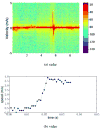A data efficient method for characterization of chameleon tongue motion using Doppler radar - PubMed (original) (raw)
A data efficient method for characterization of chameleon tongue motion using Doppler radar
Aditya Singh et al. Annu Int Conf IEEE Eng Med Biol Soc. 2012.
Abstract
A new technique is described for study of the study of high velocity animal movements using a continuous wave Doppler radar operating at 24 GHz. The movement studied was tongue projection kinematics during prey capture by the lizard Chamaeleo Jacksonii. The measurements were verified with a high speed video reference, recorded at 1000 frames per second. The limitations and advantages of both the methodologies are compared and tongue speeds of 3:65 m/s were observed. These results show a useful application of radar to augment visual sensing of biological motion and enable the use of monitoring in a wider range of situations.
Figures
Fig. 1
Chameleon poised to strike a cricket clipped in place above the radar (with a flat-head alligator clip). Note the ruler below the perch for length reference.
Fig. 2
Sketch of test setup seen from above. The cricket is located just above the radar antennas and the perch (wooden branch) is situated to locate the chameleon's head at the level of the radar antennas. The camera is about 1 m away from the radar antenna and perch.
Fig. 3
Plots of tongue speed for the second experiment as determined from (a) radar and (b) video data. The tongue motion appears as a short spike of motion in the radar data and not like the step seen in the video data because the radar monitored the chameleon for a much longer time than the high speed video camera. Even at this higher sample rate and longer duration of observation the data from the radar system is much more manageable. The reported maximum speed for both the radar and video measurements (with equivalent sample times) showed excellent agreement at 3.64 m/s and 3.65 m/s, respectively.
Fig. 4
Radar output of chameleon striking bait with indications of automatically determined strike time(s). This information can be used to quickly focus attention on times for analysis and saving video. Though the data was analyzed after the experiment, the strike indication could be generated in real time using a similar algorithm.
Fig. 5
Radar baseband output signals I and Q plotted for 300 ms (top) and 100 ms (bottom) showing the speed difference between tongue protrusion and tongue projection during the strike.
Fig. 6
Chameleon shortly after striking cricket, in the process of drawing its tongue (and the now attached cricket) back to its mouth. Visible in this still frame are parts of its tongue moving in different ways: what little motion the base has is generally vertical (waving it up and down) while the thinner middle portion is behaving more like a cable or rope and the thicker part at the end with the cricket is swinging back like a weight. Unlike the earlier tongue projection, this set of motions do not appear independently in the radar output and measuring this interplay during tongue retraction would be very difficult if not impossible with a single radar system.
Similar articles
- Comparative study of tongue protrusion in three iguanian lizards, Sceloporus undulatus, Pseudotrapelus sinaitus and Chamaeleo jacksonii.
Meyers JJ, Nishikawa KC. Meyers JJ, et al. J Exp Biol. 2000 Sep;203(Pt 18):2833-49. doi: 10.1242/jeb.203.18.2833. J Exp Biol. 2000. PMID: 10952882 - Morphology and fibre-type distribution in the tongue of the Pogona vitticeps lizard (Iguania, Agamidae).
Zghikh LN, Vangysel E, Nonclercq D, Legrand A, Blairon B, Berri C, Bordeau T, Rémy C, Burtéa C, Montuelle SJ, Bels V. Zghikh LN, et al. J Anat. 2014 Oct;225(4):377-89. doi: 10.1111/joa.12224. Epub 2014 Aug 11. J Anat. 2014. PMID: 25109482 Free PMC article. Review. - The scaling of tongue projection in the veiled chameleon, Chamaeleo calyptratus.
Herrel A, Redding CL, Meyers JJ, Nishikawa KC. Herrel A, et al. Zoology (Jena). 2014 Aug;117(4):227-36. doi: 10.1016/j.zool.2014.01.001. Epub 2014 Mar 19. Zoology (Jena). 2014. PMID: 24703241 - The functional morphology of lingual prey capture in a scincid lizard, Tiliqua scincoides (Reptilia: Squamata).
Hewes AE, Schwenk K. Hewes AE, et al. J Morphol. 2021 Jan;282(1):127-145. doi: 10.1002/jmor.21287. Epub 2020 Oct 22. J Morphol. 2021. PMID: 33090536 - Not So Fast: Swimming Behavior of Sailfish during Predator-Prey Interactions using High-Speed Video and Accelerometry.
Marras S, Noda T, Steffensen JF, Svendsen MB, Krause J, Wilson AD, Kurvers RH, Herbert-Read J, Boswell KM, Domenici P. Marras S, et al. Integr Comp Biol. 2015 Oct;55(4):719-27. doi: 10.1093/icb/icv017. Epub 2015 Apr 21. Integr Comp Biol. 2015. PMID: 25898843 Review.
Cited by
- Shooting Mechanisms in Nature: A Systematic Review.
Sakes A, van der Wiel M, Henselmans PW, van Leeuwen JL, Dodou D, Breedveld P. Sakes A, et al. PLoS One. 2016 Jul 25;11(7):e0158277. doi: 10.1371/journal.pone.0158277. eCollection 2016. PLoS One. 2016. PMID: 27454125 Free PMC article.
References
- Wainwright P, Kraklau D, Bennett A. Kinematics of tongue projection in Chamaeleo oustaleti. Journal of experimental biology. 1991;159(1):109.
- Flanders M. Visually guided head movement in the African chameleon. Vision Research. 1985;25(7):935–942. [Online]. Available: http://www.sciencedirect.com/science/article/pii/0042698985902044. - PubMed
- Lin J. Noninvasive microwave measurement of respiration. Proceedings of the IEEE. 1975;63(10):1530–1530.
- Nanzer J, Anderson M, Josserand T, et al. Detection of moving intruders from a moving platform using a Ka-band continuous-wave doppler radar. Antennas and Propagation Society International Symposium, 2009 APSURSI '09 IEEE. 2009 Jun;:1–4.
- Park BK, Boric-Lubecke O, Lubecke VM. Arctangent demodulation with dc offset compensation in quadrature Doppler radar receiver systems. Microwave Theory and Techniques, IEEE Transactions on. 2007 May;55(5):1073–1079. - PubMed
Publication types
MeSH terms
LinkOut - more resources
Full Text Sources





